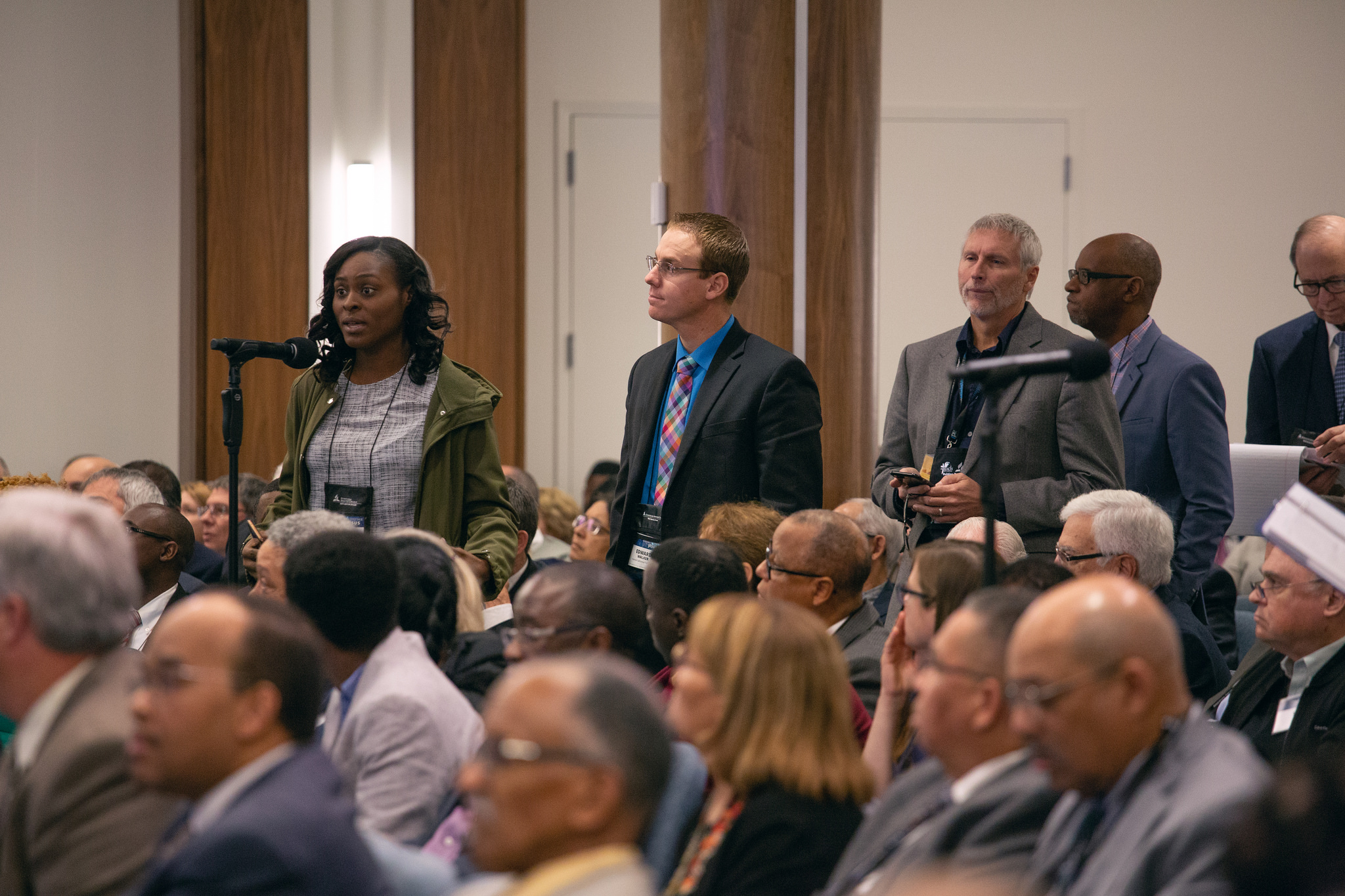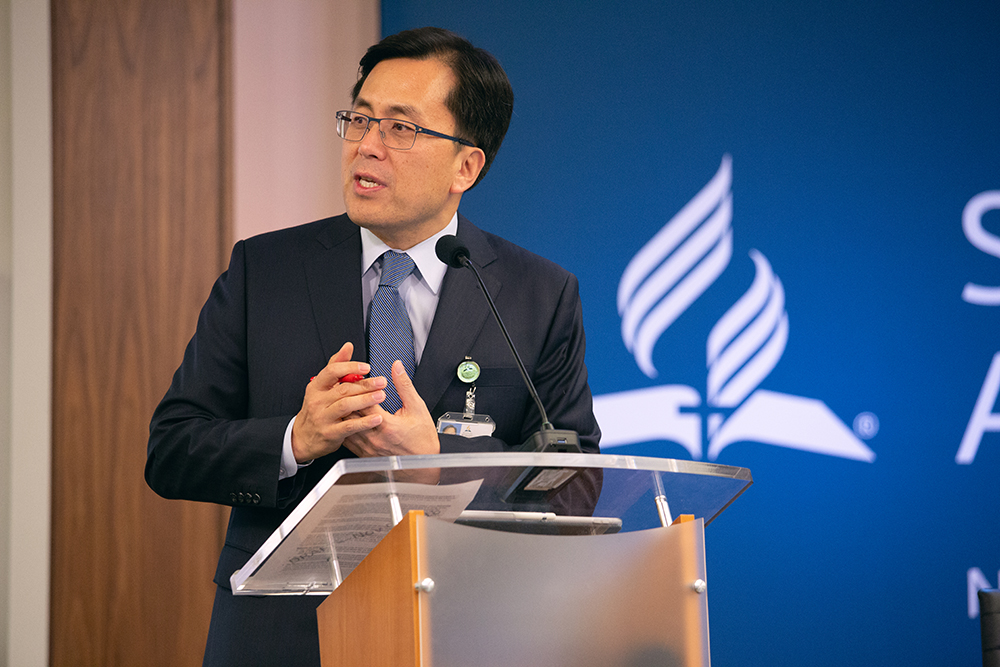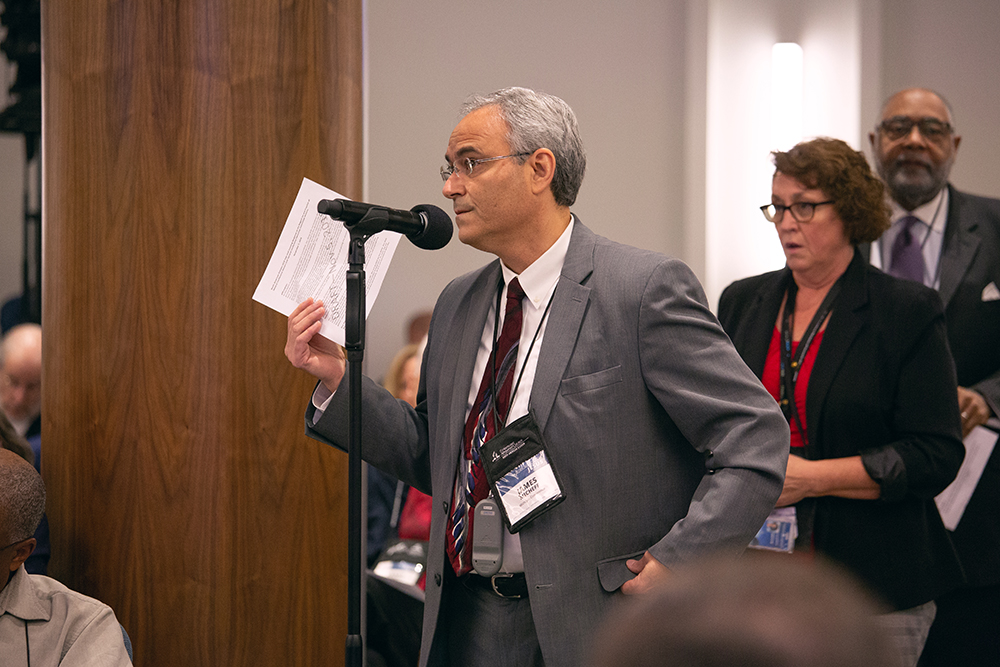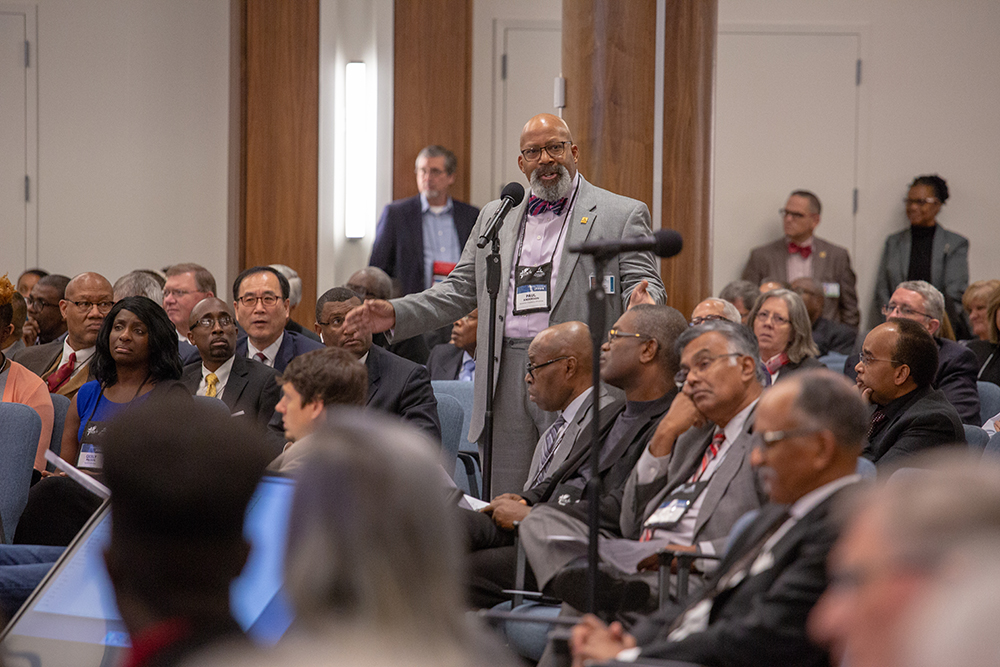On Nov. 4, 2018, the morning business session of the North American Division Year-End Meeting (NAD YEM) was devoted to a discussion on the voted General Conference (GC) document titled “Regard for and Practice of General Conference Session and General Conference Executive Committee Actions.”
The GC Executive Committee, at its Annual Council meeting this past October, approved the creation of a new compliance process to assist with the need to implement church policies and voted actions.The process is outlined in the voted GC document to which the NAD was responding.
Before the dialogue started, Daniel R. Jackson, president of the Seventh-day Adventist Church in North America (NAD), said that he hoped that the time would be prayerful and cathartic — and that the executive committee would be able to draw some conclusions from the discussion.
“We are not going to present you with documents so that you get on your knees and pray and agree with us. The Holy Spirit does not eliminate opinions,” said Jackson. But, he also asked that “those participating in the conversation not “name names,” requesting that those commenting “extend dignity to the other idea or other person who has spoken.”
Jackson then allotted about 3.5 hours for the discussion and time to give specific suggestions to a committee voted before the commencement of the discussion. This nine-person committee, including pastors, conference and union church leaders, a student, a lay member, and a division officer, was assigned to draft a written response to the GC from the NAD on the GC document. The committee worked over a 24-hour period to craft the two-page response; the document was shared on Nov. 6.

Discussion
Before specific suggestions were given on the floor — and sent later to the committee via email — the discussion on the GC document ensued. Not only was the NAD auditorium filled, the discussion was watched live by more than 1,500 people on Facebook, YouTube, and the NAD website.
Many delegates expressed unhappiness over the GC document — the majority disagreed entirely with what they believe the document represents, while a few agreed with the general intent of the document, but not the process it laid out. A few called for the NAD to be mindful of potential fallout if its leadership responds unfavorably with the GC document. Other delegates spoke about their experiences in the church, and gave opinions on ways to move forward — advancing the mission and ministry of the Adventist Church in North America.
Two Adventist Intercollegiate Association representatives spoke early in the discussion. Ashton Hardin, student body president at La Sierra University (California) and one of two NAD YEM assigned prayer conveners, said, “It’s easy for emotions to cloud our judgement, [and] cloud how we go about conversations. And today we are digging deeper into that conversation, inviting people to talk, [and] express their feelings. But I also think it’s important to remember that at the end of the day, we are all one family. We are all brothers and sisters in Christ. … We [need to] remember that Jesus is in the center of all our discussions.”
Tchiana Augustin, student association president at Burman University (Canada), called for affirmation of the need for gender equality in the church. “We need an affirming statement that there is a home for our female students accepting the call to serve the ministry that is currently rejecting them,” said Augustin. “What can I tell my students who are considering leaving our school or changing their majors because there is no future for them at our church? I myself cannot understand how a woman can function as spiritual [laity] and not as clergy. How are we qualifiable [sic] to offer spiritual guidance as educated persons, but not as ordained spiritual authority?”
Augustin also made a plea for more communication. “I have held a negative image of our conference since the release of this document because I had not heard anything from anyone until I got here — and there are many people who feel the same way. We’re losing members of our church, and our youth. … What initiatives does the NAD have to reconcile this?”
Including university, conference, and union presidents, members with long histories in the church also spoke. One was E. Edward Zinke, a theologian and businessman, who spoke on his time on the 1973 committee for the General Conference that studied the role of women in the church as it pertains to ordination.
“I was on the committee that studied the role of women in the church,” said Zinke. “We discovered that there was no theological objection to the ordination of women. I believe that each committee that has been assigned since has overwhelmingly had the same result as our committee.”
Zinke listed suggestions for the writing committee, which included adding an emphasis that reflects the division’s commitment to biblical doctrine. He also suggested making a call for dialogue, referencing the 1973 study committee. “Conversation doesn’t take place in two-minute bites with 400 people or 2,000 people. It takes place in smaller groups.”
Leslie Pollard, Oakwood University (Alabama) president, added additional historical context to the discussion. “Like the nation on whose soil we stand, our church wrestles with ideological forces designed to divide us. These forces are deep, they are cultural ideological differences,” he said. “And while this document is not directly about ordination, the subtext clearly is ordination — the ordination of women in ministry. I have the pleasure of living with and serving hundreds of millennials and Gen-Zs, and I can assure you [that] when they see injustice institutionalized by majority vote, it is a cause for disillusionment.”
Pollard described how the current situation took him back to his childhood, when, 55 years ago, Martin Luther King Jr. was condemned by southern clergymen who wanted King to stop his “illegal practices.” Pollard gave this quote from King’s response to the clergymen: “We should never forget that everything Adolf Hitler did to the Jews in Germany was legal. It was illegal to aid and comfort a Jew in Hitler’s Germany.”
“When a law is unjust, every law that supports it is also unjust,” added Pollard. “When a policy is unjust, every policy that supports it is also unjust. The policy before us today is unjust because the policy that it supports — the one that institutionalizes and [discriminates] against women in ministry — is unjust, unbiblical, and unscriptural. This policy should be rejected because it attempts to sustain what is unsustainable: discrimination in the body of Christ.”
Vanessa Pujic, a teacher in the Minnesota Conference, described herself as a young adult mother, Midwesterner, Adventist high school teacher, and former pastor who felt compelled to speak during the NAD YEM discussion. “I wholeheartedly reject the compliance document that was voted at Annual Council,” Pujic said. “And I call upon our division leadership to reject it. In fact, I call upon all 13 of our division executive committee [leaders] to reject the document, which places far too much power in the hands of a few and does not allow for the collective decisions reached as constituents of a particular region … to determine what works in their context.”
Pujic also addressed an underlying issue of the treatment of women in pastoral ministry, saying, “How disappointing that my church continues to ignore that obvious call of God in the lives of these many women who serve as pastors. With this kind of perception from the church they love, who but [a] woman called of God would dare to serve? … It is time to let the scales fall from our eyes and bear witness to the Spirit of God calling on our sons andour daughters. To the GC leaders I would say, ‘Please reject the temptation of hierarchy and hold others up so that in doing this, you may be the servant leaders that Jesus has called all of us to be.’”
The discussion wrapped at a few minutes after 12 noon; at 2 p.m. the writing committee began crafting the response in a board room of the NAD headquarters, after reviewing several dozen suggestions they received.

The Response
In the morning on Nov. 6, Kyoshin Ahn, undersecretary for the NAD, introduced the document prepared by the writing committee in response to the voted action of the GC Executive Committee at Annual Council. John Freedman, North Pacific Union Conference president, offered prayer before the reading of document.
Freedman read the two-page response document aloud as delegates followed along with paper draft copies. Upon sharing the document, Jackson opened discussion.
While most comments were in support of the response document, during this discussion period some cautioned that the NAD consider that the response may set precedent on how local churches communicate with the local conference. Concern was also expressed in how this response document will be taken in light of the motion voted the previous day, which calls for dialogue with the GC on tithe parity. One delegate said that “we should be like Jesus, self-sacrificing.”

James Micheff, president of the Michigan Conference, told those gathered that “this is his family.” He explained concerns about the response’s three requests of action, saying that they reject the authority of the GC, which could have broad implications around the globe, causing the church to lose “its worldwide status.” Micheff also raised concern about not following voted church policy on women’s ordination, and about the NAD voting to keep abundance that God has given at home.
“I love this Church, this is my Church,” said Micheff. “I am not in any way discouraged. If this [document is voted], the Michigan Conference is part of the North American Division of the General Conference and will not be in violation of any policy … you are still my brothers and sisters. We may not agree, but I can still walk beside you as brother and sister.”
Micheff concluded, “I know God is going to bring unity. This is one Church, one family. I don’t know how He is going to do it, but He will. … When He does we will give that loud cry message and Jesus is going to come.”
As mentioned, the majority of those who spoke expressed appreciation for the document.
Darrel Lindensmith, a pastor in the Dakota Conference, admitted that he did not have high expectations for the document beforehand but, upon reading it, was impressed. “Perfect” was the word Lindensmith used to describe the second page; thanking the committee, he suggested tightening the first page “a little bit.”
Paul Anderson, director of Adventist Chaplaincy Ministries in the NAD, said he stands in support of the document. He then related a personal experience when he saw a family arguing in a parking lot when he was a Navy chaplain. Anderson witnessed the patriarch of the family punch the wife in the face. “I tried to keep walking,” Anderson said. But as the argument intensified and the man turned to brutalize the woman again, Anderson said, “I couldn’t keep going. … I got between him and her. It was violence that was interdicted in that moment, and I can’t help but feel, as I’ve watched this over the past 30 years, that every time we say ‘no’ to the women God has called we are brutalizing them. I stand in their defense and I hope you will too.”
After about an hour discussion, and two short periods of prayer, Jackson asked the delegates to use three guiding principles in the decision on voting: does it advance the mission of the NAD; will it pass the Christ-likeness test; and will the decision be consistent with biblical principles.
With a vote of 176-48, the NAD Executive Committee approved the document, entitled “North American Division 2018 Year-end Meeting Response to the Regard for and Practice of General Conference Session and General Conference Executive Committee Actions.”
The writing committee met during lunch to address minor edits to the copy. After several departments and ministries gave reports that afternoon, Ahn shared these adjustments with the delegates, including the addition of a final sentence to the document: “It is our sincere hope that the future will be characterized by continual prayer and open dialogue, empowered by “him who is able to do far more abundantly than all that we ask or think” (Eph. 3:20, ESV).
— Click here to read a PDF of the response document. And click here to read the response from the 2018 NAD Year-End Meeting young adult delegates.




